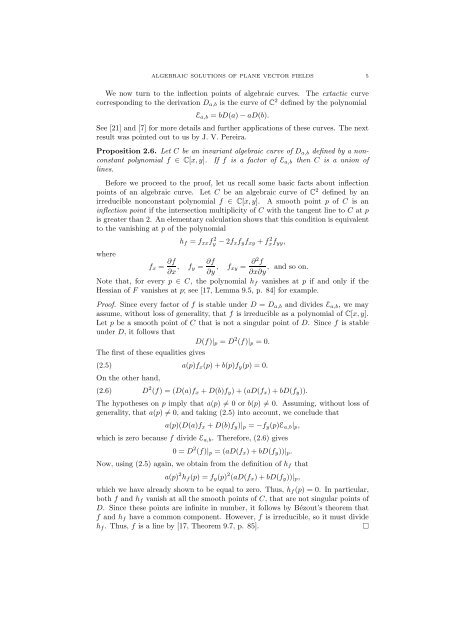ALGEBRAIC SOLUTIONS OF PLANE VECTOR FIELDS ... - dCC-UFRJ
ALGEBRAIC SOLUTIONS OF PLANE VECTOR FIELDS ... - dCC-UFRJ
ALGEBRAIC SOLUTIONS OF PLANE VECTOR FIELDS ... - dCC-UFRJ
Create successful ePaper yourself
Turn your PDF publications into a flip-book with our unique Google optimized e-Paper software.
<strong>ALGEBRAIC</strong> <strong>SOLUTIONS</strong> <strong>OF</strong> <strong>PLANE</strong> <strong>VECTOR</strong> <strong>FIELDS</strong> 5<br />
We now turn to the inflection points of algebraic curves. The extactic curve<br />
corresponding to the derivation Da,b is the curve of C 2 defined by the polynomial<br />
Ea,b = bD(a) − aD(b).<br />
See [21] and [7] for more details and further applications of these curves. The next<br />
result was pointed out to us by J. V. Pereira.<br />
Proposition 2.6. Let C be an invariant algebraic curve of Da,b defined by a nonconstant<br />
polynomial f ∈ C[x, y]. If f is a factor of Ea,b then C is a union of<br />
lines.<br />
Before we proceed to the proof, let us recall some basic facts about inflection<br />
points of an algebraic curve. Let C be an algebraic curve of C 2 defined by an<br />
irreducible nonconstant polynomial f ∈ C[x, y]. A smooth point p of C is an<br />
inflection point if the intersection multiplicity of C with the tangent line to C at p<br />
is greater than 2. An elementary calculation shows that this condition is equivalent<br />
to the vanishing at p of the polynomial<br />
where<br />
hf = fxxf 2 y − 2fxfyfxy + f 2 x fyy,<br />
fx = ∂f<br />
∂x , fy = ∂f<br />
∂y , fxy = ∂2f , and so on.<br />
∂x∂y<br />
Note that, for every p ∈ C, the polynomial hf vanishes at p if and only if the<br />
Hessian of F vanishes at p; see [17, Lemma 9.5, p. 84] for example.<br />
Proof. Since every factor of f is stable under D = Da,b and divides Ea,b, we may<br />
assume, without loss of generality, that f is irreducible as a polynomial of C[x, y].<br />
Let p be a smooth point of C that is not a singular point of D. Since f is stable<br />
under D, it follows that<br />
D(f)|p = D 2 (f)|p = 0.<br />
The first of these equalities gives<br />
(2.5)<br />
On the other hand,<br />
(2.6)<br />
a(p)fx(p) + b(p)fy(p) = 0.<br />
D 2 (f) = (D(a)fx + D(b)fy) + (aD(fx) + bD(fy)).<br />
The hypotheses on p imply that a(p) = 0 or b(p) = 0. Assuming, without loss of<br />
generality, that a(p) = 0, and taking (2.5) into account, we conclude that<br />
a(p)(D(a)fx + D(b)fy)|p = −fy(p)Ea,b|p,<br />
which is zero because f divide Ea,b. Therefore, (2.6) gives<br />
0 = D 2 (f)|p = (aD(fx) + bD(fy))|p.<br />
Now, using (2.5) again, we obtain from the definition of hf that<br />
a(p) 2 hf(p) = fy(p) 2 (aD(fx) + bD(fy))|p,<br />
which we have already shown to be equal to zero. Thus, hf(p) = 0. In particular,<br />
both f and hf vanish at all the smooth points of C, that are not singular points of<br />
D. Since these points are infinite in number, it follows by Bézout’s theorem that<br />
f and hf have a common component. However, f is irreducible, so it must divide<br />
hf. Thus, f is a line by [17, Theorem 9.7, p. 85].
















